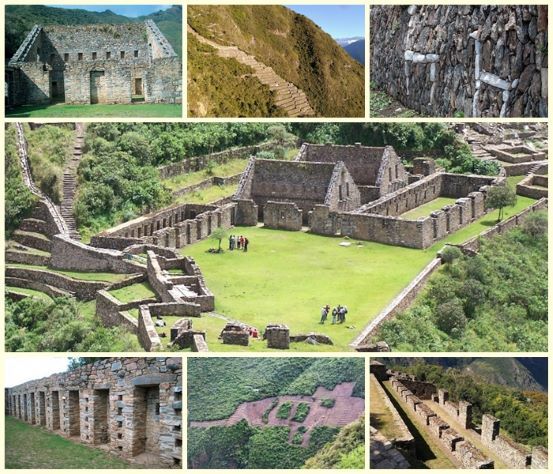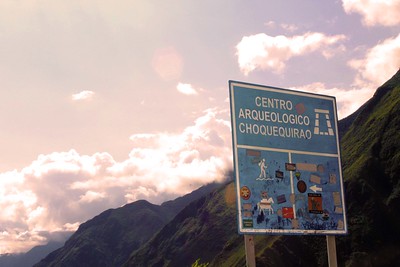Choquequirao is located in the Vilcabamba Valley in the province of La Convencion – Cusco at an altitude of 3300 m.a.s.l. and at 1500 m. over the roaring waters of the Apurímac River.
According to the chronicles Choquequirao in Perú was the last Inca refuge from 1536.
Choquequirao comes from the meaning chuqui which means gold and from the word k’iraw which means cradle, that is to say “Cradle of Gold”.
The construction is made up of terraces and buildings at different levels, from the lowest level known as Sunch’u Pata to the highest truncated summit.

choquequirao apurimac 
choquequirao
The Choquequirao Archaeological Park is known as the “Sacred Sister” for being as important as Machu Picchu, for its architecture and design used in construction. The city is an inspiring example of a ceremonial center of the Inca elite, dedicated to the worship of the gods of the mountain, the river and the elements of nature.
The landscape is spectacular, the enclosure is surrounded by majestic snow-capped mountains, the main one being the Salkantay mountain and by deep slopes of vegetation typical of the jungle.
Where is Choquequirao Archaeological Park located?
Choquequirao is located at 3,103 meters above sea level. in a privileged location: it lies on the impressive canyon of the Urubamba River.
It is located in the foothills of the Salkantay Mountain, in the Apurímac Valley, in the province of La Convencion in Cusco, Peru.
What does Choquequirao mean?
Choquequirao means “Cradle of Gold” in Quechua. It is considered the city ‘Sister of Machu Picchu’, due to its similarities with the Inca City.
In truth, its architecture is as impressive as that of Machu Picchu.
At the moment Choquequirao has the advantage of not receiving the number of visitors that its ‘Big sister’ receives.
Few people know Choquequirao. Perhaps due to the difficult walk it takes to get there.
What is the architecture like in Choquequirao in Perú?
Choquequirao has numerous Inca buildings. However, currently only 30% of its entire area has been excavated.
Its most important buildings are made of quartzite, cut in great detail. The rest of the walls are made of raw stone.
These walls were covered with clay both inside and out.
The walls of Choquequirao are believed to have been painted light orange. Although in reality there are few structures that continue with this coating.
What to see in Choquequirao Archaeological Park?
The ancient city of Choquequirao has two main squares, temples, fountains, canals, workshops, warehouses, elite residences and more common ones.
The ceremonial center of Choquequirao is a large platform that can only be reached through a double jamb door.
The largest buildings in the area are the colcas (warehouses).
Like Machu Picchu, Choquequirao has structures that mark solar events such as solstices and equinoxes.
How to get to Choquequirao in Perú
Route through Cachora
The Choquequirao Trek 4 Days is the most recommended, if you want comfort you can choose to rent a mule driver to carry your luggage, since mules can travel on this route without difficulty.
From Cusco we take a private transport that will take us along the Abancay road, at km 154 we take the detour that will take us to Cachora, (approximately 4 or 5 hours of travel) In this place is the concentration, the muleteers will be waiting for us to start our adventure, the rental price of each mule is 20 soles per day and if you want mule driver service you must increase about 20 soles more.
The road is narrow but in good condition, reaching Choquequirao requires good physical condition and adequate equipment for hiking. It is necessary to go down to the Apurímac river to camp.
Our second day we will dedicate ourselves to climb up to 3,085 meters above sea level. of altitude, until arriving at the Archaeological Complex of Choquequiraw, to return we will use the same path.
We must be careful when going up the Apurimac river towards Choquequirao since it is very narrow, it is best to carry little weight.










